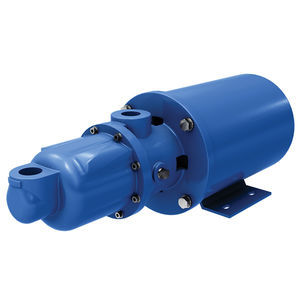
Chemical pump LXBslurrymagnetic-driveprogressing cavity

Add to favorites
Compare this product
Characteristics
- Fluid
- for chemicals, slurry
- Operation
- magnetic-drive
- Technology
- progressing cavity
- Mobility
- stationary
- Domain
- industrial
- Applications
- handling
- Material
- aluminum, PVC, titanium, nickel
- Other characteristics
- skid-mounted
- Flow
Min.: 135 us gal/min
(511.03059 l/min)Max.: 1,250 us gal/min
(4,731.76473 l/min)- Pressure
Min.: 0 psi
Max.: 1,044 psi
- Power
Min.: 0.37 kW
(0.5 hp)Max.: 1.1 kW
(1.5 hp)- Length
Min.: 803 mm
(32 in)Max.: 1,027 mm
(40 in)- Height
Min.: 168 mm
(6.61 in)Max.: 340 mm
(13.39 in)- Weight
15 kg
(33.07 lb)
Description
Mag Drive series are the first progressing cavity wobble stator pumps to offer magnetic drives. The proprietary, magnetic coupling design performs well in hazardous applications and is effective with difficult-to-seal fluids. This ensures operator safety and protects the environment from contamination.
Features
Patented, sealless technology provides zero leakage, preserving expensive fluids, eliminating hazardous work place conditions and protecting the environment
No mechanical seals are used, eliminating costly repairs
Pulsation-free, low shear pumping action maintains product integrity
No vapor locking when handling gaseous, volatile liquids
Four models from which to choose for application versatility
Various motor options available
Materials of construction include PVC housings
Stator materials include FPM with optional Nitrile and EPDM; Titanium rotors are standard
Skid mounted, turnkey systems are available for one-stop, hassle-free shopping, saving time and money
Typical Applications
Sodium Hypochlorite
Ammonia
Hydrogen Peroxide
Ferric Chloride
Aluminum Chloride
Ammonium Chloride
Calcium Chloride
Nickel Chloride
Catalogs
Dosing pump
2 Pages
Related Searches
- Pump
- Industrial pump
- Pump with electric motor
- Stationary pump
- Clear water pump
- Centrifugal pump
- Chemical pump
- Self-priming pump
- Stainless steel pump
- Lubricant pump
- Transfer pump
- Chemistry pump
- Lubricating oil pump
- Compact pump
- Suction pump
- Mechanically-actuated pump
- Food product pump
- Flow pump
- Discharge pump
- Top-mounted pump
*Prices are pre-tax. They exclude delivery charges and customs duties and do not include additional charges for installation or activation options. Prices are indicative only and may vary by country, with changes to the cost of raw materials and exchange rates.



